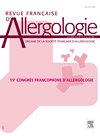牙科诊所的神秘过敏反应
IF 0.3
4区 医学
引用次数: 0
摘要
我们报告的情况下,一个年轻的男孩谁被转介到我们的怀疑过敏反应,局部麻醉在牙科手术。在使用肾上腺素阿卡因局部麻醉后不久,他出现了2级过敏反应,并通过肌肉注射肾上腺素治疗。由于无法测试阿替卡因(仍与肾上腺素混合),我们测试了利多卡因作为替代品,然后进行了皮下激发试验,该试验没有引起任何反应,允许我们排除利多卡因过敏。然而,我们在用氯己定消毒后进行的皮肤试验显示乳胶阳性,我们最初怀疑乳胶是过敏反应的原因。但对未经处理、未用氯己定消毒的皮肤进行对照刺痛试验,结果为阴性。在进一步询问后,我们发现患者在局部麻醉前使用了含有氯己定的漱口水,而牙医和家属最初都没有提到这一点。氯己定针刺试验和特异性IgE试验均为阳性,最终证实对氯己定敏感。因此,这是一种ige介导的氯己定过敏,可能是由于牙龈局部麻醉引起的粘膜吸收裂口。这个病例提醒我们需要一个系统和彻底的方法来评估药物过敏。在调查围手术期过敏反应时,应始终考虑对氯己定过敏,即使该产品在完整的皮肤或粘膜上耐受性良好。本文章由计算机程序翻译,如有差异,请以英文原文为准。
Réaction anaphylactique énigmatique au cabinet dentaire
We report the case of a young boy who was referred to us for suspected anaphylaxis to a local anesthetic during a dental procedure. Shortly after the administration of a local anesthesia using adrenaline-laced articaine, he developed a grade 2 anaphylactic reaction, which was treated with an intramuscular injection of adrenaline. Unable to test articaine (which was still mixed with adrenaline), we tested lidocaine as an alternative and then performed a subcutaneous provocation test, which did not elicit any reaction, allowing us to rule out a lidocaine allergy. However, our skin tests, performed after disinfection with chlorhexidine, were positive for latex, which we initially suspected to be responsible for the anaphylactic reaction. But a control prick-test on untreated skin, not disinfected with chlorhexidine, was negative. Upon further questioning, we discovered that the patient had used a mouthwash containing chlorhexidine immediately before the local anesthesia, which had not initially been mentioned either by the dentist or by the family. The chlorhexidine prick-test, as well as specific IgE testing, both returned positive, ultimately confirming sensitization to chlorhexidine. This was therefore an IgE-mediated allergy to chlorhexidine, likely due to mucosal absorption through the breach caused by the gingival local anesthesia. This case serves as a reminder of the need for a systematic and thorough approach in evaluating drug hypersensitivity. Allergy to chlorhexidine should always be considered when investigating perioperative anaphylaxis, even when the product is well tolerated on intact skin or mucous membranes.
求助全文
通过发布文献求助,成功后即可免费获取论文全文。
去求助
来源期刊

Revue Francaise d Allergologie
Medicine-Immunology and Allergy
自引率
33.30%
发文量
349
期刊介绍:
La Revue Française d''Allergologie : un véritable forum pour faire connaître des travaux originaux et permettre la diffusion de l''information auprès de toutes les spécialités concernées par les pathologies allergiques. La Revue Française d''Allergologie (8 numéros par an) est au carrefour de nombreuses spécialités - dermatologie, pédiatrie, ORL, pneumologie, ophtalmologie, médecine interne - qui, toutes, ont à traiter des maladies allergiques. Les symptômes des allergies fondés sur des mécanismes communs sont le plus souvent associés et se succèdent chez un même patient. En forte progression depuis 20 ans, les maladies allergiques sont dans l''attente de perfectionnements et d''avancées thérapeutiques qui permettront aux nombreux patients qui en sont atteints de mieux vivre avec leurs allergies. La Revue Française d''Allergologie se veut donc un véritable forum de discussions et d''échanges entre tous les spécialistes confrontés aux pathologies
 求助内容:
求助内容: 应助结果提醒方式:
应助结果提醒方式:


